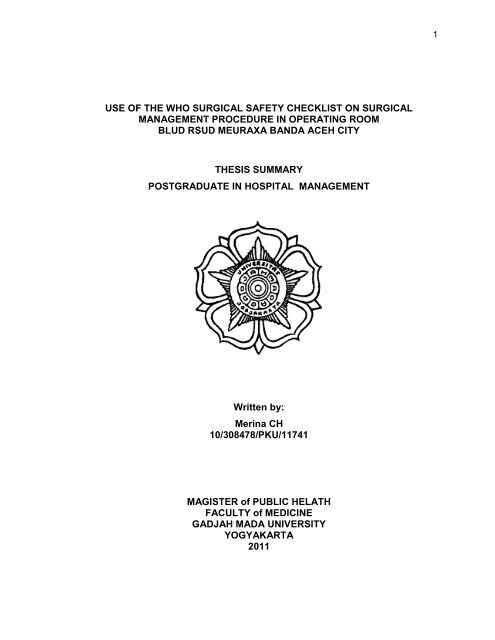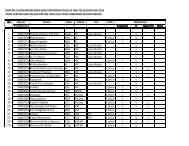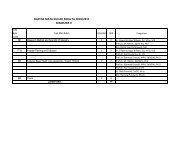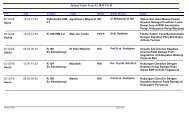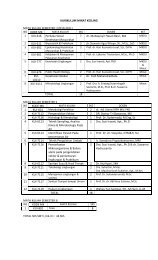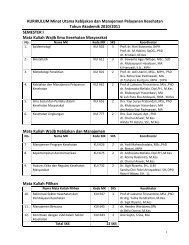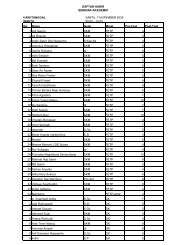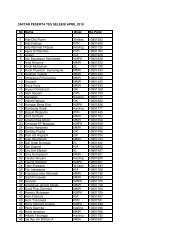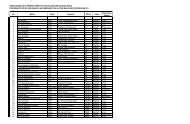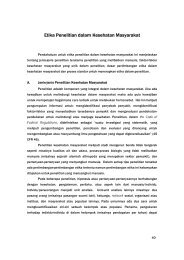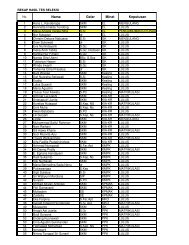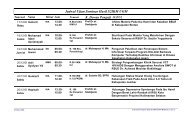use of the who surgical safety checklist on surgical management
use of the who surgical safety checklist on surgical management
use of the who surgical safety checklist on surgical management
You also want an ePaper? Increase the reach of your titles
YUMPU automatically turns print PDFs into web optimized ePapers that Google loves.
1<br />
USE OF THE WHO SURGICAL SAFETY CHECKLIST ON SURGICAL<br />
MANAGEMENT PROCEDURE IN OPERATING ROOM<br />
BLUD RSUD MEURAXA BANDA ACEH CITY<br />
THESIS SUMMARY<br />
POSTGRADUATE IN HOSPITAL MANAGEMENT<br />
Written by:<br />
Merina CH<br />
10/308478/PKU/11741<br />
MAGISTER <str<strong>on</strong>g>of</str<strong>on</strong>g> PUBLIC HELATH<br />
FACULTY <str<strong>on</strong>g>of</str<strong>on</strong>g> MEDICINE<br />
GADJAH MADA UNIVERSITY<br />
YOGYAKARTA<br />
2011
2<br />
USE OF THE WHO SURGICAL SAFETY CHECKLIST ON SURGICAL<br />
MANAGEMENT PROCEDURE IN OPERATING ROOM<br />
BLUD RSUD MEURAXA BANDA ACEH CITY<br />
Merina CH<br />
10/308478/PKU/11741<br />
Approved by:<br />
Supervisor<br />
Pr<str<strong>on</strong>g>of</str<strong>on</strong>g>. dr. Iwan Dwiprahasto., MMedSc., PhD<br />
Tanggal:
3<br />
USE OF THE WHO SURGICAL SAFETY CHECKLIST ON SURGICAL MANAGEMENT<br />
PROCEDURE IN OPERATING ROOM<br />
BLUD RSUD MEURAXA BANDA ACEH CITY<br />
Merina CH 1 , Iwan Dwiprahasto 2<br />
ABSTRACT<br />
Background: A surgery is <strong>on</strong>e <str<strong>on</strong>g>of</str<strong>on</strong>g> medical treatments aimed to save <strong>on</strong>e’s live, prevent<br />
from disability and complicati<strong>on</strong>. However, <str<strong>on</strong>g>the</str<strong>on</strong>g> effect <str<strong>on</strong>g>of</str<strong>on</strong>g> surgery can ca<str<strong>on</strong>g>use</str<strong>on</strong>g> death and<br />
handicap such as from <str<strong>on</strong>g>surgical</str<strong>on</strong>g> wound infecti<strong>on</strong>. RSUD Meuraxa Banda Aceh city in 2010,<br />
<str<strong>on</strong>g>the</str<strong>on</strong>g>re were 4 post <str<strong>on</strong>g>surgical</str<strong>on</strong>g> patients suffered from dehiscence in <str<strong>on</strong>g>the</str<strong>on</strong>g> suture <str<strong>on</strong>g>surgical</str<strong>on</strong>g><br />
operati<strong>on</strong>. There have been rarely prophylaxis antibiotic adducti<strong>on</strong>s to pre <str<strong>on</strong>g>surgical</str<strong>on</strong>g><br />
patients. There have also been latency and cancellati<strong>on</strong> for <str<strong>on</strong>g>the</str<strong>on</strong>g> surgery. One <str<strong>on</strong>g>of</str<strong>on</strong>g> <str<strong>on</strong>g>the</str<strong>on</strong>g> efforts<br />
to decrease <str<strong>on</strong>g>the</str<strong>on</strong>g> number <str<strong>on</strong>g>of</str<strong>on</strong>g> infecti<strong>on</strong>s to <str<strong>on</strong>g>surgical</str<strong>on</strong>g> wound is by using WHO <str<strong>on</strong>g>surgical</str<strong>on</strong>g> <str<strong>on</strong>g>safety</str<strong>on</strong>g><br />
<str<strong>on</strong>g>checklist</str<strong>on</strong>g>.<br />
Objectives: To find out to what extent is <str<strong>on</strong>g>the</str<strong>on</strong>g> suitability <str<strong>on</strong>g>of</str<strong>on</strong>g> <str<strong>on</strong>g>surgical</str<strong>on</strong>g> operati<strong>on</strong>s in operating<br />
room RSUD Meuraxa Banda Aceh City with WHO <str<strong>on</strong>g>surgical</str<strong>on</strong>g> <str<strong>on</strong>g>safety</str<strong>on</strong>g> <str<strong>on</strong>g>checklist</str<strong>on</strong>g>s and <str<strong>on</strong>g>the</str<strong>on</strong>g><br />
impact toward <str<strong>on</strong>g>the</str<strong>on</strong>g> <str<strong>on</strong>g>surgical</str<strong>on</strong>g> outcomes.<br />
Method: This is an observati<strong>on</strong>al research using secti<strong>on</strong>al cross design. The dependent<br />
variable is <str<strong>on</strong>g>the</str<strong>on</strong>g> number <str<strong>on</strong>g>of</str<strong>on</strong>g> surgery wound infecti<strong>on</strong>s and <str<strong>on</strong>g>the</str<strong>on</strong>g> independent variables are <str<strong>on</strong>g>the</str<strong>on</strong>g><br />
characteristics <str<strong>on</strong>g>of</str<strong>on</strong>g> <str<strong>on</strong>g>surgical</str<strong>on</strong>g> patients, prophylaxis antibiotics and WHO <str<strong>on</strong>g>surgical</str<strong>on</strong>g> <str<strong>on</strong>g>safety</str<strong>on</strong>g><br />
<str<strong>on</strong>g>checklist</str<strong>on</strong>g>. The data were collected through observati<strong>on</strong> using <str<strong>on</strong>g>checklist</str<strong>on</strong>g> toward <str<strong>on</strong>g>surgical</str<strong>on</strong>g> and<br />
prophylaxis antibiotics operati<strong>on</strong>al procedure. The data <str<strong>on</strong>g>the</str<strong>on</strong>g>n were analyzed by using<br />
frequency distributi<strong>on</strong>, percentage and chi square test. The subjects <str<strong>on</strong>g>of</str<strong>on</strong>g> this research are all<br />
<str<strong>on</strong>g>surgical</str<strong>on</strong>g> patients from 1 nd <str<strong>on</strong>g>of</str<strong>on</strong>g> June to 15 th <str<strong>on</strong>g>of</str<strong>on</strong>g> July 2011 in RSUD Meuraxa Banda Aceh city.<br />
Analysis and results: The variable <str<strong>on</strong>g>of</str<strong>on</strong>g> subject characteristics <str<strong>on</strong>g>of</str<strong>on</strong>g> age and educati<strong>on</strong> are<br />
significant to <str<strong>on</strong>g>surgical</str<strong>on</strong>g> wound infecti<strong>on</strong> occurrence (p value
4<br />
INTRODUCTION<br />
Surgery is an integral part <str<strong>on</strong>g>of</str<strong>on</strong>g> health care and is <strong>on</strong>e <str<strong>on</strong>g>of</str<strong>on</strong>g> <str<strong>on</strong>g>the</str<strong>on</strong>g> important acti<strong>on</strong>s<br />
in medical. This surgery is <strong>on</strong>e <str<strong>on</strong>g>of</str<strong>on</strong>g> <str<strong>on</strong>g>the</str<strong>on</strong>g> medical act which aims to save lives,<br />
prevent disability and complicati<strong>on</strong>s. However, <str<strong>on</strong>g>surgical</str<strong>on</strong>g>ly performed can also<br />
engender a complicati<strong>on</strong> may endanger <str<strong>on</strong>g>the</str<strong>on</strong>g> life. 1<br />
Data 56 (29%) surgery <str<strong>on</strong>g>of</str<strong>on</strong>g> <str<strong>on</strong>g>the</str<strong>on</strong>g> 192 countries members <str<strong>on</strong>g>of</str<strong>on</strong>g> <str<strong>on</strong>g>the</str<strong>on</strong>g> WHO and <str<strong>on</strong>g>the</str<strong>on</strong>g><br />
estimated 234.2 dissecti<strong>on</strong> (95% CI-281.2 187.2) take place each year around <str<strong>on</strong>g>the</str<strong>on</strong>g><br />
world. One milli<strong>on</strong> patients died <str<strong>on</strong>g>of</str<strong>on</strong>g> surgery, ei<str<strong>on</strong>g>the</str<strong>on</strong>g>r during surgery or after surgery<br />
and 7 o<str<strong>on</strong>g>the</str<strong>on</strong>g>r milli<strong>on</strong> patients experienced complicati<strong>on</strong>s. 2<br />
Wound infecti<strong>on</strong> is <str<strong>on</strong>g>the</str<strong>on</strong>g> third largest operati<strong>on</strong> that ca<str<strong>on</strong>g>use</str<strong>on</strong>g> nosocomial<br />
infecti<strong>on</strong>s. Wound infecti<strong>on</strong> led to operati<strong>on</strong> morbditas, mortality and extend <str<strong>on</strong>g>the</str<strong>on</strong>g><br />
period <str<strong>on</strong>g>of</str<strong>on</strong>g> inpatient in <str<strong>on</strong>g>the</str<strong>on</strong>g> Hospital thus increasing maintenance costs between 10%<br />
to 20% are wound infecti<strong>on</strong> surgery. The costs incurred by <str<strong>on</strong>g>the</str<strong>on</strong>g> patient and <str<strong>on</strong>g>the</str<strong>on</strong>g><br />
patient's family when it is not <str<strong>on</strong>g>the</str<strong>on</strong>g> occurrence <str<strong>on</strong>g>of</str<strong>on</strong>g> infecti<strong>on</strong>s <str<strong>on</strong>g>of</str<strong>on</strong>g> wounds operati<strong>on</strong>s is $<br />
31.523 but with <str<strong>on</strong>g>the</str<strong>on</strong>g> existence <str<strong>on</strong>g>of</str<strong>on</strong>g> operati<strong>on</strong> wound infecti<strong>on</strong> becomes $ 75007. This<br />
has resulted in material losses and imateril in patients and <str<strong>on</strong>g>the</str<strong>on</strong>g>ir families. 3.4.5<br />
In <str<strong>on</strong>g>the</str<strong>on</strong>g> Act <str<strong>on</strong>g>of</str<strong>on</strong>g> surgery, <str<strong>on</strong>g>the</str<strong>on</strong>g> patient characteristics allow <str<strong>on</strong>g>the</str<strong>on</strong>g> occurrence <str<strong>on</strong>g>of</str<strong>on</strong>g><br />
infecti<strong>on</strong> with surgery wounds. The characteristics <str<strong>on</strong>g>of</str<strong>on</strong>g> <str<strong>on</strong>g>the</str<strong>on</strong>g>se patients include:<br />
diabetes, smoking, steroids l<strong>on</strong>g-term, obesity, age, status and lack <str<strong>on</strong>g>of</str<strong>on</strong>g> nutrients by<br />
<str<strong>on</strong>g>the</str<strong>on</strong>g> transfusi<strong>on</strong> <str<strong>on</strong>g>of</str<strong>on</strong>g> operati<strong>on</strong>. 5 Educati<strong>on</strong> is very influential <strong>on</strong> <str<strong>on</strong>g>the</str<strong>on</strong>g> subject <str<strong>on</strong>g>of</str<strong>on</strong>g> healthy<br />
behavior, withhigher educati<strong>on</strong> level <str<strong>on</strong>g>the</str<strong>on</strong>g> higher <str<strong>on</strong>g>the</str<strong>on</strong>g> knowledge. As for o<str<strong>on</strong>g>the</str<strong>on</strong>g>r factors<br />
that affect wound infecti<strong>on</strong>s in Obstetrics and surgery SMF c<strong>on</strong>tent <str<strong>on</strong>g>of</str<strong>on</strong>g>. Dr. Sardjito<br />
Hospital Yogyakarta, that <str<strong>on</strong>g>the</str<strong>on</strong>g> quality and skills <str<strong>on</strong>g>of</str<strong>on</strong>g> <str<strong>on</strong>g>the</str<strong>on</strong>g> operator <str<strong>on</strong>g>of</str<strong>on</strong>g> <str<strong>on</strong>g>the</str<strong>on</strong>g> resident OR =<br />
6,03 (95% CI: 12,03-18.02) statistically meaningful with P & Lt; 0.05. 6 Good<br />
collaborati<strong>on</strong> between surge<strong>on</strong>s, anes<str<strong>on</strong>g>the</str<strong>on</strong>g>sia and nurses very important in <str<strong>on</strong>g>the</str<strong>on</strong>g><br />
<strong>management</strong> <str<strong>on</strong>g>surgical</str<strong>on</strong>g> room. 7 Communicati<strong>on</strong> errors in <str<strong>on</strong>g>surgical</str<strong>on</strong>g> team is <str<strong>on</strong>g>the</str<strong>on</strong>g> ca<str<strong>on</strong>g>use</str<strong>on</strong>g> <str<strong>on</strong>g>of</str<strong>on</strong>g><br />
<str<strong>on</strong>g>the</str<strong>on</strong>g> occurrence <str<strong>on</strong>g>of</str<strong>on</strong>g> an error in surgery, ei<str<strong>on</strong>g>the</str<strong>on</strong>g>r <strong>on</strong> <str<strong>on</strong>g>the</str<strong>on</strong>g> side <str<strong>on</strong>g>of</str<strong>on</strong>g> <str<strong>on</strong>g>the</str<strong>on</strong>g> surgery as well as in
5<br />
o<str<strong>on</strong>g>the</str<strong>on</strong>g>r <str<strong>on</strong>g>surgical</str<strong>on</strong>g> procedures <str<strong>on</strong>g>the</str<strong>on</strong>g>refore need good communicati<strong>on</strong> and cooperati<strong>on</strong> in<br />
<str<strong>on</strong>g>surgical</str<strong>on</strong>g> teamwork to improve patient <str<strong>on</strong>g>safety</str<strong>on</strong>g>.<br />
Surgical wound infecti<strong>on</strong> rates (ILO) can be scaled with antibioticprophylaxis<br />
and timing <str<strong>on</strong>g>of</str<strong>on</strong>g> administrati<strong>on</strong> should be appropriate. One way for granting an<br />
antibiotic prophylactic at <str<strong>on</strong>g>the</str<strong>on</strong>g> proper time is by a guide <str<strong>on</strong>g>surgical</str<strong>on</strong>g> <str<strong>on</strong>g>safety</str<strong>on</strong>g> <str<strong>on</strong>g>checklist</str<strong>on</strong>g>. <str<strong>on</strong>g>the</str<strong>on</strong>g><br />
<str<strong>on</strong>g>use</str<strong>on</strong>g> <str<strong>on</strong>g>of</str<strong>on</strong>g> <str<strong>on</strong>g>surgical</str<strong>on</strong>g> <str<strong>on</strong>g>safety</str<strong>on</strong>g> <str<strong>on</strong>g>checklist</str<strong>on</strong>g> can optimize <str<strong>on</strong>g>the</str<strong>on</strong>g> time <str<strong>on</strong>g>of</str<strong>on</strong>g> <str<strong>on</strong>g>the</str<strong>on</strong>g> granting <str<strong>on</strong>g>of</str<strong>on</strong>g> an antibiotic<br />
prophylactic before <str<strong>on</strong>g>the</str<strong>on</strong>g> dissecti<strong>on</strong>. 8<br />
Surgical <str<strong>on</strong>g>safety</str<strong>on</strong>g> <str<strong>on</strong>g>checklist</str<strong>on</strong>g> c<strong>on</strong>tains 19 items WHO is to be d<strong>on</strong>e in three<br />
stages, before inducti<strong>on</strong> <str<strong>on</strong>g>of</str<strong>on</strong>g> anes<str<strong>on</strong>g>the</str<strong>on</strong>g>sia (sign in), before <str<strong>on</strong>g>the</str<strong>on</strong>g> skin incisi<strong>on</strong>s (time out)<br />
and leave <str<strong>on</strong>g>the</str<strong>on</strong>g> operating room before <str<strong>on</strong>g>the</str<strong>on</strong>g> patient (sign out). The <str<strong>on</strong>g>use</str<strong>on</strong>g> <str<strong>on</strong>g>of</str<strong>on</strong>g> <str<strong>on</strong>g>surgical</str<strong>on</strong>g><br />
<str<strong>on</strong>g>safety</str<strong>on</strong>g> <str<strong>on</strong>g>checklist</str<strong>on</strong>g> <str<strong>on</strong>g>who</str<strong>on</strong>g> is adjusted to <str<strong>on</strong>g>the</str<strong>on</strong>g> c<strong>on</strong>diti<strong>on</strong> <str<strong>on</strong>g>of</str<strong>on</strong>g> a hospital. 9<br />
Functi<strong>on</strong> <str<strong>on</strong>g>of</str<strong>on</strong>g> <str<strong>on</strong>g>the</str<strong>on</strong>g> <str<strong>on</strong>g>surgical</str<strong>on</strong>g> <str<strong>on</strong>g>safety</str<strong>on</strong>g> <str<strong>on</strong>g>checklist</str<strong>on</strong>g> is providing informati<strong>on</strong> that details<br />
about <str<strong>on</strong>g>the</str<strong>on</strong>g> case which is being worked <strong>on</strong>, c<strong>on</strong>firm <str<strong>on</strong>g>the</str<strong>on</strong>g> details, <str<strong>on</strong>g>the</str<strong>on</strong>g> focus <str<strong>on</strong>g>of</str<strong>on</strong>g><br />
discussi<strong>on</strong> and <str<strong>on</strong>g>the</str<strong>on</strong>g> formati<strong>on</strong> <str<strong>on</strong>g>of</str<strong>on</strong>g> <str<strong>on</strong>g>the</str<strong>on</strong>g> penyuaraan team. Besides that discussi<strong>on</strong><br />
ceklist also gives <str<strong>on</strong>g>the</str<strong>on</strong>g> opportunity for educati<strong>on</strong> and decisi<strong>on</strong> maker. Of members <str<strong>on</strong>g>of</str<strong>on</strong>g><br />
a team <str<strong>on</strong>g>the</str<strong>on</strong>g> operati<strong>on</strong> <str<strong>on</strong>g>of</str<strong>on</strong>g> emphasized <str<strong>on</strong>g>the</str<strong>on</strong>g> importance <str<strong>on</strong>g>of</str<strong>on</strong>g> informati<strong>on</strong> and cooperati<strong>on</strong><br />
<str<strong>on</strong>g>the</str<strong>on</strong>g> team as a functi<strong>on</strong> most important <str<strong>on</strong>g>of</str<strong>on</strong>g> ceklist. 10<br />
In ind<strong>on</strong>esia has issued a decree health minister No<br />
382/menkes/SK/III/2007 c<strong>on</strong>cerning <str<strong>on</strong>g>the</str<strong>on</strong>g> implementati<strong>on</strong> <str<strong>on</strong>g>of</str<strong>on</strong>g> <str<strong>on</strong>g>the</str<strong>on</strong>g> preventi<strong>on</strong> and<br />
c<strong>on</strong>trol infecti<strong>on</strong>s in hospitals and health care facilities ano<str<strong>on</strong>g>the</str<strong>on</strong>g>r as an attempt to<br />
decide cycle <str<strong>on</strong>g>the</str<strong>on</strong>g> c<strong>on</strong>tagi<strong>on</strong> <str<strong>on</strong>g>of</str<strong>on</strong>g> disease and protect <str<strong>on</strong>g>the</str<strong>on</strong>g> patient, medic, visitors and<br />
<str<strong>on</strong>g>the</str<strong>on</strong>g> people <str<strong>on</strong>g>who</str<strong>on</strong>g> receives health services, ei<str<strong>on</strong>g>the</str<strong>on</strong>g>r in a hospital or facility o<str<strong>on</strong>g>the</str<strong>on</strong>g>r health<br />
services. 11<br />
Regi<strong>on</strong>al General Hospital (RSUD) meuraxa <str<strong>on</strong>g>the</str<strong>on</strong>g> city <str<strong>on</strong>g>of</str<strong>on</strong>g> banda aceh is a<br />
hospital a public service agancy <str<strong>on</strong>g>the</str<strong>on</strong>g> area <str<strong>on</strong>g>of</str<strong>on</strong>g> class B <str<strong>on</strong>g>who</str<strong>on</strong>g> became a hospital <str<strong>on</strong>g>the</str<strong>on</strong>g><br />
referent <str<strong>on</strong>g>of</str<strong>on</strong>g> in <str<strong>on</strong>g>the</str<strong>on</strong>g> area <str<strong>on</strong>g>of</str<strong>on</strong>g> a city Banda Aceh and had a duty carry out <str<strong>on</strong>g>the</str<strong>on</strong>g> service <str<strong>on</strong>g>of</str<strong>on</strong>g><br />
<str<strong>on</strong>g>the</str<strong>on</strong>g> treatment, <str<strong>on</strong>g>the</str<strong>on</strong>g> recovery <str<strong>on</strong>g>of</str<strong>on</strong>g> an increase in health and <str<strong>on</strong>g>the</str<strong>on</strong>g> preventi<strong>on</strong> <str<strong>on</strong>g>of</str<strong>on</strong>g> disease<br />
that is executed through <str<strong>on</strong>g>the</str<strong>on</strong>g> service <str<strong>on</strong>g>of</str<strong>on</strong>g> inpatient, outpatient, emergency room, and<br />
<str<strong>on</strong>g>the</str<strong>on</strong>g> act <str<strong>on</strong>g>of</str<strong>on</strong>g> medical based <strong>on</strong> <str<strong>on</strong>g>the</str<strong>on</strong>g> regulati<strong>on</strong>.
6<br />
This hospital having a number <str<strong>on</strong>g>of</str<strong>on</strong>g> a bed 136, and have service between<br />
o<str<strong>on</strong>g>the</str<strong>on</strong>g>rs: <str<strong>on</strong>g>surgical</str<strong>on</strong>g> poliklinik 1, 1 space <str<strong>on</strong>g>surgical</str<strong>on</strong>g> man, 1 space <str<strong>on</strong>g>surgical</str<strong>on</strong>g> woman, 1<br />
installati<strong>on</strong> <str<strong>on</strong>g>surgical</str<strong>on</strong>g> middlemost having 3 chamber operati<strong>on</strong>s (2 <str<strong>on</strong>g>the</str<strong>on</strong>g> operating<br />
room large rooms small operati<strong>on</strong>s and 1), recovery room and space sterility<br />
instrument. The number <str<strong>on</strong>g>of</str<strong>on</strong>g> operati<strong>on</strong>s in 2009 is 655 operati<strong>on</strong>s and 715 operati<strong>on</strong><br />
in 2010. The incidence <str<strong>on</strong>g>of</str<strong>on</strong>g> <str<strong>on</strong>g>surgical</str<strong>on</strong>g> wound infecti<strong>on</strong>s in Meuraxa hospitals<br />
Banda Aceh not in <str<strong>on</strong>g>the</str<strong>on</strong>g> know beca<str<strong>on</strong>g>use</str<strong>on</strong>g> it has never been any research or data<br />
<strong>on</strong> nosocomial infecti<strong>on</strong>s and<str<strong>on</strong>g>surgical</str<strong>on</strong>g> wound infecti<strong>on</strong>s. Nosocomial infecti<strong>on</strong><br />
c<strong>on</strong>trol team is newly formed at <str<strong>on</strong>g>the</str<strong>on</strong>g> end <str<strong>on</strong>g>of</str<strong>on</strong>g> 2010. in 2010 as much as 4 patients<br />
after an operati<strong>on</strong> that experiencing dehisiensi at a seam scrapes operati<strong>on</strong> so as<br />
to need d<strong>on</strong>e operati<strong>on</strong> re xamined. Delivery <str<strong>on</strong>g>of</str<strong>on</strong>g> antibiotic prophylaxis in patients<br />
before surgery was rarely performed, it is still a delay and <str<strong>on</strong>g>the</str<strong>on</strong>g> cancellati<strong>on</strong> <str<strong>on</strong>g>of</str<strong>on</strong>g><br />
surgery.<br />
RESEARCH OBJECTIVES<br />
The general objective <str<strong>on</strong>g>of</str<strong>on</strong>g> this research is to know <str<strong>on</strong>g>the</str<strong>on</strong>g> extent <str<strong>on</strong>g>of</str<strong>on</strong>g> compliance<br />
acti<strong>on</strong> surgery in Meuraxa hospital Banda Aceh City with <str<strong>on</strong>g>surgical</str<strong>on</strong>g> <str<strong>on</strong>g>safety</str<strong>on</strong>g> <str<strong>on</strong>g>checklist</str<strong>on</strong>g><br />
WHO and <str<strong>on</strong>g>the</str<strong>on</strong>g>ir impact <strong>on</strong> <str<strong>on</strong>g>the</str<strong>on</strong>g> outcome <str<strong>on</strong>g>of</str<strong>on</strong>g> surgery.<br />
MATERIALS AND RESEARCH METHOD<br />
The research was c<strong>on</strong>ducted at a Meuraxa hospital in Banda Aceh, <str<strong>on</strong>g>of</str<strong>on</strong>g> this<br />
research is observasi<strong>on</strong>al plan cross secti<strong>on</strong>al. This research is subject to <str<strong>on</strong>g>the</str<strong>on</strong>g><br />
patients <str<strong>on</strong>g>who</str<strong>on</strong>g> underwent surgery <strong>on</strong> a planned from June 1 to July 15, 2011. The<br />
collecti<strong>on</strong> <str<strong>on</strong>g>of</str<strong>on</strong>g> data with <str<strong>on</strong>g>the</str<strong>on</strong>g> data in <str<strong>on</strong>g>the</str<strong>on</strong>g> <str<strong>on</strong>g>checklist</str<strong>on</strong>g> can <str<strong>on</strong>g>the</str<strong>on</strong>g>n examine, through <str<strong>on</strong>g>the</str<strong>on</strong>g><br />
analysis <str<strong>on</strong>g>of</str<strong>on</strong>g> <str<strong>on</strong>g>the</str<strong>on</strong>g> data in two stages, i.e. univariate and bivariate. Univariate analysis<br />
was c<strong>on</strong>ducted to find out <str<strong>on</strong>g>the</str<strong>on</strong>g> frequency distributi<strong>on</strong> <str<strong>on</strong>g>of</str<strong>on</strong>g> each independent variable.<br />
Analysis <str<strong>on</strong>g>of</str<strong>on</strong>g> bivariat to see <str<strong>on</strong>g>the</str<strong>on</strong>g> influence <str<strong>on</strong>g>of</str<strong>on</strong>g> <str<strong>on</strong>g>the</str<strong>on</strong>g> dependent variable for each<br />
independent variable.
7<br />
RESEARCH AND DISCUSSIONS<br />
1. Characteristic subject<br />
Based <strong>on</strong> <str<strong>on</strong>g>the</str<strong>on</strong>g> results <str<strong>on</strong>g>of</str<strong>on</strong>g> an analysis <str<strong>on</strong>g>of</str<strong>on</strong>g> <str<strong>on</strong>g>the</str<strong>on</strong>g> relati<strong>on</strong> <str<strong>on</strong>g>of</str<strong>on</strong>g> characteristic <str<strong>on</strong>g>of</str<strong>on</strong>g><br />
<str<strong>on</strong>g>the</str<strong>on</strong>g> subject with <str<strong>on</strong>g>the</str<strong>on</strong>g> occurrence <str<strong>on</strong>g>of</str<strong>on</strong>g> an infecti<strong>on</strong> in a wound <str<strong>on</strong>g>the</str<strong>on</strong>g> operati<strong>on</strong> <str<strong>on</strong>g>of</str<strong>on</strong>g><br />
that has been carried at 60 <str<strong>on</strong>g>the</str<strong>on</strong>g> subject <str<strong>on</strong>g>of</str<strong>on</strong>g> study, from <str<strong>on</strong>g>the</str<strong>on</strong>g> eighth variable<br />
characteristic <str<strong>on</strong>g>of</str<strong>on</strong>g> <str<strong>on</strong>g>the</str<strong>on</strong>g> subject (age, educati<strong>on</strong>, sex, a class <str<strong>on</strong>g>of</str<strong>on</strong>g> care, diagnose<br />
<str<strong>on</strong>g>surgical</str<strong>on</strong>g>, a comorbidities, <str<strong>on</strong>g>the</str<strong>on</strong>g> day <str<strong>on</strong>g>of</str<strong>on</strong>g> care and <str<strong>on</strong>g>the</str<strong>on</strong>g> operator <str<strong>on</strong>g>surgical</str<strong>on</strong>g>) visible<br />
two characteristic <str<strong>on</strong>g>of</str<strong>on</strong>g> a subject that are meaningful increase my risk <str<strong>on</strong>g>of</str<strong>on</strong>g> <str<strong>on</strong>g>the</str<strong>on</strong>g><br />
occurrence <str<strong>on</strong>g>of</str<strong>on</strong>g> an infecti<strong>on</strong> <str<strong>on</strong>g>of</str<strong>on</strong>g> a wound <str<strong>on</strong>g>the</str<strong>on</strong>g> operati<strong>on</strong> <str<strong>on</strong>g>of</str<strong>on</strong>g> ie sub characteristic<br />
<str<strong>on</strong>g>of</str<strong>on</strong>g> <str<strong>on</strong>g>the</str<strong>on</strong>g> subject <str<strong>on</strong>g>of</str<strong>on</strong>g> aged and sub karakteriktik educati<strong>on</strong> with magnitudes p<<br />
0.005. Risk factors <str<strong>on</strong>g>of</str<strong>on</strong>g> infecti<strong>on</strong> <str<strong>on</strong>g>of</str<strong>on</strong>g> operati<strong>on</strong> wound, namely: <str<strong>on</strong>g>the</str<strong>on</strong>g> <str<strong>on</strong>g>surgical</str<strong>on</strong>g> risk<br />
factors (age, sex, diagnosis, complicati<strong>on</strong> surgery, intra venous attached,<br />
l<strong>on</strong>g day pre surgery ca<str<strong>on</strong>g>the</str<strong>on</strong>g>ter is inserted, <str<strong>on</strong>g>the</str<strong>on</strong>g> time <str<strong>on</strong>g>of</str<strong>on</strong>g> urine antibiotic<br />
prophylaxis and hair shearing time pubis), risk factors during surgery<br />
(surgery, complicati<strong>on</strong>s <str<strong>on</strong>g>of</str<strong>on</strong>g> old surgery, complicati<strong>on</strong>s <str<strong>on</strong>g>of</str<strong>on</strong>g> anes<str<strong>on</strong>g>the</str<strong>on</strong>g>sia and<br />
antibiotics added) and risk factors <str<strong>on</strong>g>of</str<strong>on</strong>g> post surgery (antibiotics, wound care<br />
and nursing care <str<strong>on</strong>g>of</str<strong>on</strong>g> old). 9 The characteristics <str<strong>on</strong>g>of</str<strong>on</strong>g> <str<strong>on</strong>g>the</str<strong>on</strong>g> subject sub class<br />
variables do not care to <str<strong>on</strong>g>the</str<strong>on</strong>g>ir risk factors to <str<strong>on</strong>g>the</str<strong>on</strong>g> occurrence <str<strong>on</strong>g>of</str<strong>on</strong>g> wound<br />
infecti<strong>on</strong> is likely due to <str<strong>on</strong>g>the</str<strong>on</strong>g> operati<strong>on</strong> in Meuraxa hospital Banda Aceh, <str<strong>on</strong>g>the</str<strong>on</strong>g><br />
level <str<strong>on</strong>g>of</str<strong>on</strong>g> hygiene diruangan aseptiknya good care and techniques and<br />
existing standard operating procedural (SOP) to replace <str<strong>on</strong>g>the</str<strong>on</strong>g> wrap cuts post<br />
operati<strong>on</strong>. Supervisi<strong>on</strong> in replacing <str<strong>on</strong>g>the</str<strong>on</strong>g> wrap <str<strong>on</strong>g>of</str<strong>on</strong>g> post operative already d<strong>on</strong>e<br />
periodically by <str<strong>on</strong>g>the</str<strong>on</strong>g> head <str<strong>on</strong>g>of</str<strong>on</strong>g> <str<strong>on</strong>g>the</str<strong>on</strong>g> chamber and chairman <str<strong>on</strong>g>of</str<strong>on</strong>g> <str<strong>on</strong>g>the</str<strong>on</strong>g> implementati<strong>on</strong><br />
<str<strong>on</strong>g>of</str<strong>on</strong>g> <str<strong>on</strong>g>the</str<strong>on</strong>g> orphanage team daily nursing.
8<br />
Table 2. Relati<strong>on</strong>ship Between Characteristics <str<strong>on</strong>g>of</str<strong>on</strong>g> Subjects With Wound<br />
Infecti<strong>on</strong> Occurrence <str<strong>on</strong>g>of</str<strong>on</strong>g> Operati<strong>on</strong>s<br />
Characteristics subjects ILO events N=60 P OR crude<br />
ILO<br />
N (%)<br />
Tidak ILO<br />
N (%)<br />
(95%CI)<br />
Age<br />
• < 21<br />
• 21-35<br />
• 36-50<br />
• ≥ 51<br />
Educati<strong>on</strong><br />
• Basic<br />
middle to upper<br />
0 (0)<br />
0 (0)<br />
2 (15,4)<br />
10 (100)<br />
11 (52,46)<br />
1 (2,6)<br />
11 (100)<br />
26 (100)<br />
11 (84,6)<br />
0 (0)<br />
10 (47,6)<br />
38 (97,4)<br />
11 (18,3)<br />
26 (43,3)<br />
13 (21,7)<br />
10 (16,7)<br />
21 (35,0)<br />
39 (65,0)<br />
0,000<br />
0,000 41,80<br />
(4,8-363,3)<br />
2. Granting <str<strong>on</strong>g>of</str<strong>on</strong>g> antibiotic prophylaxis<br />
Table 2. Relati<strong>on</strong>ship between pr<str<strong>on</strong>g>of</str<strong>on</strong>g>ilaksis antibiotics (AP) with <str<strong>on</strong>g>the</str<strong>on</strong>g> wound<br />
operati<strong>on</strong> infecti<strong>on</strong>s<br />
Pr<str<strong>on</strong>g>of</str<strong>on</strong>g>ilaksis antibiotics ILO events N=60 P OR crude<br />
ILO<br />
N (%)<br />
Tidak ILO<br />
N (%)<br />
(95%CI)<br />
AP Given<br />
• Yes<br />
• No<br />
2 (5,1)<br />
10 (47,6)<br />
37 (94,6)<br />
11 (52,4)<br />
39 (65,0)<br />
21 (35,0)<br />
0.000<br />
16,8<br />
(3,2-88,5)<br />
The time <str<strong>on</strong>g>of</str<strong>on</strong>g><br />
granting AP<br />
• ≤ 60 minute<br />
• > 60 minute<br />
1 (4,0)<br />
1 (7,1)<br />
24 (96,0)<br />
13 (92,9)<br />
N=39<br />
25 (64,1)<br />
14 (35,9)<br />
0,669<br />
1,8<br />
(0,1-32,0)<br />
From a statistical analysis <str<strong>on</strong>g>of</str<strong>on</strong>g> this research was to find <str<strong>on</strong>g>the</str<strong>on</strong>g> meaning <str<strong>on</strong>g>of</str<strong>on</strong>g><br />
significant (p
9<br />
Prophylaxis antibiotics are given to help prevent <str<strong>on</strong>g>the</str<strong>on</strong>g> occurrence <str<strong>on</strong>g>of</str<strong>on</strong>g><br />
infecti<strong>on</strong>s. Administering an antibiotic prophylaxis 30 minutes before<br />
surgery. The granting <str<strong>on</strong>g>of</str<strong>on</strong>g> antibiotics prophylaxis is <str<strong>on</strong>g>the</str<strong>on</strong>g> main thing must be<br />
c<strong>on</strong>sidered, <str<strong>on</strong>g>the</str<strong>on</strong>g> granting <str<strong>on</strong>g>of</str<strong>on</strong>g> antibiotics pr<str<strong>on</strong>g>of</str<strong>on</strong>g>ilasis advised 60 minutes before<br />
incisi<strong>on</strong> is <str<strong>on</strong>g>the</str<strong>on</strong>g> first <str<strong>on</strong>g>of</str<strong>on</strong>g> lea<str<strong>on</strong>g>the</str<strong>on</strong>g>r is carried, <str<strong>on</strong>g>the</str<strong>on</strong>g> <str<strong>on</strong>g>use</str<strong>on</strong>g> <str<strong>on</strong>g>of</str<strong>on</strong>g> antibiotics prophylaxis an<br />
hour before incisi<strong>on</strong>s first <strong>on</strong> <str<strong>on</strong>g>the</str<strong>on</strong>g> skin can be lowered infecti<strong>on</strong> scrapes<br />
operati<strong>on</strong>s. 13<br />
Administering an antibiotic prophylaxis prior to surgery performed in<br />
are still rarely performed Meuraxa Hospital Banda Aceh city, is due to <str<strong>on</strong>g>the</str<strong>on</strong>g><br />
presence <str<strong>on</strong>g>of</str<strong>on</strong>g> SOP and yet <str<strong>on</strong>g>the</str<strong>on</strong>g> provisi<strong>on</strong>s c<strong>on</strong>cerning antibiotic prophylaxis<br />
and administering prophylaxis antibiotic timing.<br />
3. Surgical <str<strong>on</strong>g>safety</str<strong>on</strong>g> cheklist (SSCL) WHO<br />
C<strong>on</strong>firmati<strong>on</strong> <str<strong>on</strong>g>of</str<strong>on</strong>g> <str<strong>on</strong>g>the</str<strong>on</strong>g><br />
<str<strong>on</strong>g>surgical</str<strong>on</strong>g> procedure<br />
• Yes<br />
• No<br />
Team nurse review<br />
Steril <str<strong>on</strong>g>surgical</str<strong>on</strong>g><br />
equipment<br />
• Yes<br />
• No<br />
Antibiotics are given 60<br />
minutes before surgery<br />
• Yes<br />
• No<br />
Table 3.<br />
Relati<strong>on</strong>ship Between <str<strong>on</strong>g>the</str<strong>on</strong>g> Use <str<strong>on</strong>g>of</str<strong>on</strong>g> Surgical suitability<br />
Safety Checklist (SSCL) WHO The occurrence <str<strong>on</strong>g>of</str<strong>on</strong>g> <str<strong>on</strong>g>the</str<strong>on</strong>g> ILO<br />
SSCL ILO N=60 P OR crude<br />
ILO Tidak ILO<br />
N (%) N (%)<br />
1 (5,3)<br />
11 (26,8)<br />
1 (2,4)<br />
11 (57,9)<br />
1 (4,0)<br />
11 (31,4)<br />
18 (94,7)<br />
30 (73,2)<br />
40 (97,6)<br />
8 (42,1)<br />
24 (96,0)<br />
24 (68,6)<br />
19 (31,7)<br />
41 (68,3)<br />
41 (68,3)<br />
19 (31,7)<br />
25 (41,2)<br />
35 (58,3)<br />
0,052<br />
0,000<br />
0,009<br />
6,6<br />
(0,7-55,4)<br />
55,0<br />
(6,19-488,1)<br />
11,0<br />
(1,3-91,9)<br />
The results showed most <str<strong>on</strong>g>of</str<strong>on</strong>g> <str<strong>on</strong>g>the</str<strong>on</strong>g> <str<strong>on</strong>g>surgical</str<strong>on</strong>g> <str<strong>on</strong>g>safety</str<strong>on</strong>g> <str<strong>on</strong>g>checklist</str<strong>on</strong>g> WHO<br />
variable does not mean significantly with <str<strong>on</strong>g>the</str<strong>on</strong>g> wound infecti<strong>on</strong> <str<strong>on</strong>g>of</str<strong>on</strong>g> sub
10<br />
operati<strong>on</strong>s but variable c<strong>on</strong>firm <str<strong>on</strong>g>surgical</str<strong>on</strong>g> procedures, <str<strong>on</strong>g>surgical</str<strong>on</strong>g> team sub<br />
variable review <str<strong>on</strong>g>surgical</str<strong>on</strong>g> equipment is sterile and sub antibotik variables are<br />
given 60 minutes before prophylactic surgery means significant (p
11<br />
poliklinik, <str<strong>on</strong>g>the</str<strong>on</strong>g> room and do <str<strong>on</strong>g>surgical</str<strong>on</strong>g>ly in a <str<strong>on</strong>g>surgical</str<strong>on</strong>g>, so that <str<strong>on</strong>g>of</str<strong>on</strong>g>ten occurs delay<br />
operati<strong>on</strong>s.<br />
4. Incident wound operati<strong>on</strong> infecti<strong>on</strong>s<br />
Digit gen infecti<strong>on</strong> operati<strong>on</strong> post dissecti<strong>on</strong> (20, %), mostly found <strong>on</strong><br />
<str<strong>on</strong>g>the</str<strong>on</strong>g> seventh day ie at a visit to poliklinik (58, 3). Of research results type<br />
infecti<strong>on</strong> scrapes operati<strong>on</strong> that is superficial SSI most (83, 3), <str<strong>on</strong>g>the</str<strong>on</strong>g> deep SSI<br />
(16,7) and organs/ space does not occur. Wound infecti<strong>on</strong>s nosocomial<br />
infecti<strong>on</strong>s third operati<strong>on</strong> is <str<strong>on</strong>g>of</str<strong>on</strong>g>ten reported, <str<strong>on</strong>g>of</str<strong>on</strong>g> <str<strong>on</strong>g>the</str<strong>on</strong>g> total patients are cared for<br />
hospitalizati<strong>on</strong> are exposed to infecti<strong>on</strong>s nosocomial 14-16% are wound<br />
infecti<strong>on</strong> surgery. Based <strong>on</strong> <str<strong>on</strong>g>the</str<strong>on</strong>g> level <str<strong>on</strong>g>of</str<strong>on</strong>g> c<strong>on</strong>taminati<strong>on</strong> <str<strong>on</strong>g>of</str<strong>on</strong>g> wounds which<br />
were operating clean c<strong>on</strong>taminated (53.3), while net classificati<strong>on</strong> (36.7) and<br />
<str<strong>on</strong>g>the</str<strong>on</strong>g> lowest classificati<strong>on</strong> <str<strong>on</strong>g>of</str<strong>on</strong>g> c<strong>on</strong>taminated (5.0) and klasfikasi dirty (5.0).<br />
Wound infecti<strong>on</strong> in general surgery is 2% to 5% <str<strong>on</strong>g>of</str<strong>on</strong>g> <str<strong>on</strong>g>the</str<strong>on</strong>g> 27 milli<strong>on</strong> patients<br />
<str<strong>on</strong>g>who</str<strong>on</strong>g> undergo surgery around <str<strong>on</strong>g>the</str<strong>on</strong>g> world each year 16 . Event operati<strong>on</strong>s post<br />
surgery infecti<strong>on</strong>s were presented in table 4.
12<br />
Table 4.<br />
Event Operati<strong>on</strong>s Post Surgery Wounds Infecti<strong>on</strong><br />
Physica scene infecti<strong>on</strong>s wound operati<strong>on</strong> N (%)<br />
N (total samples)<br />
60<br />
<str<strong>on</strong>g>the</str<strong>on</strong>g> occurrence <str<strong>on</strong>g>of</str<strong>on</strong>g> wound surgery<br />
• Yes<br />
12 (20,0)<br />
• No<br />
48 (80,0)<br />
N (total samples)<br />
• Time <str<strong>on</strong>g>of</str<strong>on</strong>g> operati<strong>on</strong> wound infecti<strong>on</strong><br />
• Day 3<br />
• Day 7<br />
• Day 21<br />
The detected infecti<strong>on</strong>s wound operati<strong>on</strong><br />
• At Inpatient<br />
• At <str<strong>on</strong>g>the</str<strong>on</strong>g> polyclinic during <str<strong>on</strong>g>the</str<strong>on</strong>g> c<strong>on</strong>trol<br />
• Readmisi<strong>on</strong><br />
Type wound operati<strong>on</strong> infecti<strong>on</strong>s<br />
• Superficial SSI<br />
• Deep SSI<br />
• Organ/ space SSI<br />
Classificati<strong>on</strong> wound operati<strong>on</strong> based<br />
mortalitas c<strong>on</strong>taminati<strong>on</strong><br />
• Clean<br />
• Clean c<strong>on</strong>taminated<br />
• C<strong>on</strong>taminated<br />
• Gross<br />
12<br />
5 (41,7)<br />
7 (58,3)<br />
0 (0)<br />
5 (41,7)<br />
7 (58,3)<br />
0 (0)<br />
10 (83,3)<br />
2 (16,7)<br />
0 (0)<br />
22 (36,7)<br />
32 (53,3)<br />
3 (5,0)<br />
3 (5,0)<br />
CONCLUSIONS AND RECOMMENDATIONS<br />
The c<strong>on</strong>clusi<strong>on</strong>s can be drawn from <str<strong>on</strong>g>the</str<strong>on</strong>g> results <str<strong>on</strong>g>of</str<strong>on</strong>g> research are: 1.<br />
characteristics <str<strong>on</strong>g>of</str<strong>on</strong>g> <str<strong>on</strong>g>the</str<strong>on</strong>g> subject sub, educati<strong>on</strong>, variable age <str<strong>on</strong>g>of</str<strong>on</strong>g> antibiotic prophylaxis,<br />
<str<strong>on</strong>g>the</str<strong>on</strong>g> provisi<strong>on</strong> <str<strong>on</strong>g>of</str<strong>on</strong>g> <str<strong>on</strong>g>the</str<strong>on</strong>g> antibiotic prophylaxis, c<strong>on</strong>firmati<strong>on</strong> <str<strong>on</strong>g>of</str<strong>on</strong>g> <str<strong>on</strong>g>surgical</str<strong>on</strong>g> procedures,<br />
<str<strong>on</strong>g>surgical</str<strong>on</strong>g> nurse review team equipment is sterile and providing prophylaxis<br />
antibiotics before surgery effect 60 minutes statistically meaningful significantly<br />
(p
13<br />
Suggesti<strong>on</strong> that can be given is: 1. Development mechanism in <str<strong>on</strong>g>the</str<strong>on</strong>g> form <str<strong>on</strong>g>of</str<strong>on</strong>g><br />
m<strong>on</strong>itoring and reporting structured: digit gen infecti<strong>on</strong> scrapes operati<strong>on</strong>s, granting<br />
antibiotic prophylactic and <str<strong>on</strong>g>the</str<strong>on</strong>g> granting <str<strong>on</strong>g>of</str<strong>on</strong>g> antibiotics in a hospital, 2. The need for<br />
attenti<strong>on</strong> to <str<strong>on</strong>g>the</str<strong>on</strong>g> improvement <str<strong>on</strong>g>of</str<strong>on</strong>g> quality <strong>management</strong> in facilitating service with <str<strong>on</strong>g>the</str<strong>on</strong>g><br />
<str<strong>on</strong>g>use</str<strong>on</strong>g> <str<strong>on</strong>g>of</str<strong>on</strong>g> <str<strong>on</strong>g>surgical</str<strong>on</strong>g> <str<strong>on</strong>g>safety</str<strong>on</strong>g> <str<strong>on</strong>g>checklist</str<strong>on</strong>g> WHO in <str<strong>on</strong>g>surgical</str<strong>on</strong>g> procedures in order to lower <str<strong>on</strong>g>the</str<strong>on</strong>g><br />
incidence <str<strong>on</strong>g>of</str<strong>on</strong>g> infecti<strong>on</strong> wound surgery; 3. Activating <str<strong>on</strong>g>the</str<strong>on</strong>g> role <str<strong>on</strong>g>of</str<strong>on</strong>g> nosocomial infecti<strong>on</strong><br />
in a team doing a c<strong>on</strong>tinuous evaluati<strong>on</strong> and m<strong>on</strong>itoring, 4. Do adopting SSCL<br />
WHO.
14<br />
REFERENCES<br />
1. Haynes, Alex, B., Weiser, Thomas, G., Berry, William, R., Lipsitz, Stuart R,<br />
Breizat, Abdel-Hadi, S., Dellinger, Patchen, Herbosa, Teodoro, Joseph,<br />
Sudhir, Kibatala, Pascience, L., Lapitan, Marie, C.M., Merry, Alan, F.,<br />
Moorthy, Krishna,. Reznick, Richard, K.,Taylor, Bryce, Gawande, Atul.<br />
(2009) A <str<strong>on</strong>g>surgical</str<strong>on</strong>g> <str<strong>on</strong>g>safety</str<strong>on</strong>g> <str<strong>on</strong>g>checklist</str<strong>on</strong>g> to reduce morbidity and mortality in a<br />
global populati<strong>on</strong>. The New England journal <str<strong>on</strong>g>of</str<strong>on</strong>g> medicine, 360(5), pp.491-9.<br />
Dale, W., Bratzler. (2005) Use <str<strong>on</strong>g>of</str<strong>on</strong>g> Antimicrobial Prophylaxis for Major<br />
Surgery: Baseline Results From <str<strong>on</strong>g>the</str<strong>on</strong>g> Nati<strong>on</strong>al Surgical Infecti<strong>on</strong> Preventi<strong>on</strong><br />
Project Arch Surg. 2005;140(2):174-182.<br />
2. Weiser, Thomas, G., Regenbogen, Scott, E., Thomps<strong>on</strong>, Ka<str<strong>on</strong>g>the</str<strong>on</strong>g>rine, D.,<br />
Haynes, Alex, B., Lipsitz, Stuart, R., Berry, William, R. (2008) An estimati<strong>on</strong><br />
<str<strong>on</strong>g>of</str<strong>on</strong>g> <str<strong>on</strong>g>the</str<strong>on</strong>g> global volume <str<strong>on</strong>g>of</str<strong>on</strong>g> surgery: a modelling strategy based <strong>on</strong> available<br />
data. The Lancet, 372(9633), pp.139-144.<br />
3. Smyth, E.T.M. & Emmers<strong>on</strong>, A.M. (1996) Surgical site infecti<strong>on</strong> surveillance<br />
Surgery, S. & Lives, S. (2008) IMPLEMENTATION MANUAL.<br />
4. Nandi, P.L., Rajan, Soundara, Mak, K.C., Chan, S.C., So, Y.P. (1999)<br />
Surgical wound infecti<strong>on</strong>. C<strong>on</strong>trol.<br />
5. Mangram, A.J., Horan, T.C., Pears<strong>on</strong>, M.L., Silver, L.C., Jarvis, W.R. (1999)<br />
Guideline for Preventi<strong>on</strong> <str<strong>on</strong>g>of</str<strong>on</strong>g> <str<strong>on</strong>g>surgical</str<strong>on</strong>g> site Infecti<strong>on</strong>. Infect C<strong>on</strong>trol Hosp<br />
Epidemiol, 20(4);250-69.<br />
6. Suparno. (2003) Faktor resiko yang berpengaruh terhadap infeksi<br />
nosocomial luka operasi di SMF kebidanan RS dr. Sardjito Yogyakarta,<br />
Tesis, Universitas Gadjah Mada.<br />
7. Makary, Martin, Sext<strong>on</strong>, J.B., Freischlag, Julie, Holzmueller, C.G., Millman,<br />
E.A., Rowen, Lisa, Pr<strong>on</strong>ovost, P.J.(2006) Operating room teamwork am<strong>on</strong>g<br />
physicians and nurses: teamwork in <str<strong>on</strong>g>the</str<strong>on</strong>g> eye <str<strong>on</strong>g>of</str<strong>on</strong>g> <str<strong>on</strong>g>the</str<strong>on</strong>g> beholder. Journal <str<strong>on</strong>g>of</str<strong>on</strong>g> <str<strong>on</strong>g>the</str<strong>on</strong>g><br />
American College <str<strong>on</strong>g>of</str<strong>on</strong>g> Surge<strong>on</strong>s, 202(5), pp.746-52.<br />
8. Vries, E., Eefje, N., Dijkstra, Lucia, Smorenburg, Susanne, M., Meijer, R.P.,<br />
Boermeester, Marja. (2010) The Surgical Patient Safety System<br />
(SURPASS) <str<strong>on</strong>g>checklist</str<strong>on</strong>g> optimizes timing <str<strong>on</strong>g>of</str<strong>on</strong>g> antibiotic prophylaxis. Patient<br />
<str<strong>on</strong>g>safety</str<strong>on</strong>g> in surgery, 4(1), p.6.<br />
9. Senior & Kathryn. (2009) WHO Surgical Safety Checklist has value<br />
worldwide. The Lancet Infectious Diseases, 9(4), pp.211-211. Smyth, E.T.M.
15<br />
& Emmers<strong>on</strong>, A.M. (1996) Surgical site infecti<strong>on</strong> surveillance Surgery, S. &<br />
Lives, S. (2008) IMPLEMENTATION MANUAL.<br />
10. Lingard, L., Espin, S., Rubin, B. 2005) Getting teams to talk: development<br />
and pilot implementati<strong>on</strong> <str<strong>on</strong>g>of</str<strong>on</strong>g> a <str<strong>on</strong>g>checklist</str<strong>on</strong>g> to promote interpr<str<strong>on</strong>g>of</str<strong>on</strong>g>essi<strong>on</strong>al<br />
communicati<strong>on</strong> in <str<strong>on</strong>g>the</str<strong>on</strong>g> OR. Quality & <str<strong>on</strong>g>safety</str<strong>on</strong>g> in health care, 14(5), pp.340-6.<br />
11. Depkes RI. (2007) Pedoman Pencegahan dan Pengendalian Infeksi di<br />
Rumah Sakit dan Fasilitas Pelayanan Kesehatan Lainnya. Jakarta: Dirjen<br />
Pelayanan Medik.<br />
12. Manuaba, I.B.G. (2000) Kapita selekta penatalaksanaan rutin obstetric<br />
ginekologi dan KB, Jakarta, EGC.Nandi, P.L., Rajan, Soundara, Mak, K.C.,<br />
Chan, S.C., So, Y.P. (1999) Surgical wound infecti<strong>on</strong>. C<strong>on</strong>trol.<br />
13. Dale, W., Bratzler. (2005) Use <str<strong>on</strong>g>of</str<strong>on</strong>g> Antimicrobial Prophylaxis for Major<br />
Surgery: Baseline Results From <str<strong>on</strong>g>the</str<strong>on</strong>g> Nati<strong>on</strong>al Surgical Infecti<strong>on</strong> Preventi<strong>on</strong><br />
Project Arch Surg. 2005;140(2):174-182.<br />
14. Lancet, The Diseases, Infectious. (2009) Safe surgery prevents infecti<strong>on</strong>.<br />
The Lancet infectious diseases, 9(4), p.203.<br />
15. Verdaasd<strong>on</strong>k, E.G.G., Stassen, L.P.S., Widhiasmara, P.P., Dankelman, J.<br />
(2009) Requirements for <str<strong>on</strong>g>the</str<strong>on</strong>g> design and implementati<strong>on</strong> <str<strong>on</strong>g>of</str<strong>on</strong>g> <str<strong>on</strong>g>checklist</str<strong>on</strong>g>s for<br />
<str<strong>on</strong>g>surgical</str<strong>on</strong>g> processes. Surgical endoscopy, 23(4), pp.715-26.<br />
16. World Aliance for patient <str<strong>on</strong>g>safety</str<strong>on</strong>g> (2005) Global Patient Safety challenge<br />
2005-2006. Geneva: WHO


